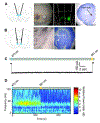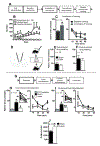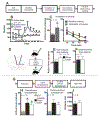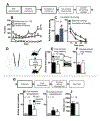Attenuation of cocaine seeking in rats via enhancement of infralimbic cortical activity using stable step-function opsins
- PMID: 30003306
- PMCID: PMC6330160
- DOI: 10.1007/s00213-018-4964-y
Attenuation of cocaine seeking in rats via enhancement of infralimbic cortical activity using stable step-function opsins
Abstract
Rationale: The infralimbic cortex (IL) and its downstream projection target the nucleus accumbens shell (NAshell) mediate the active suppression of cocaine-seeking behavior. Although an optogenetic approach would be beneficial for stimulating the IL and its efferents to study their role during reinstatement of cocaine seeking, the use of channelrhodopsin introduces significant difficulties, as optimal stimulation parameters are not known.
Objectives: The present experiments utilized a stable step-function opsin (SSFO) to potentiate endogenous activity in the IL and in IL terminals in the NAshell during cocaine-seeking tests to determine how these manipulations affect cocaine-seeking behaviors.
Methods: Rats first underwent 6-h access cocaine self-administration followed by 21-27 days in the homecage. Rats then underwent cue-induced and cocaine-primed drug-seeking tests during which the optogenetic manipulation was given. The same rats then underwent extinction training, followed by cue-induced and cocaine-primed reinstatements.
Results: Potentiation of endogenous IL activity did not significantly alter cue-induced or cocaine-primed drug seeking following the homecage period. However, following extinction training, enhancement of endogenous IL activity attenuated cue-induced reinstatement by 35% and cocaine-primed reinstatement by 53%. Stimulation of IL terminals in the NAshell did not consistently alter cocaine-seeking behavior.
Conclusion: These results suggest the utility of an SSFO-based approach for enhancing activity in a structure without driving specific patterns of neuronal firing. However, the utility of an SSFO-based approach for axon terminal stimulation remains unclear. Moreover, these results suggest that the ability of the IL to reduce cocaine seeking depends, at least in part, on rats first having undergone extinction training.
Keywords: Channelrhodopsin; Cocaine seeking; Incubation of craving; Optogenetics; Reinstatement.
Conflict of interest statement
Conflict of interest statement:
On behalf of all authors, the corresponding author states that there is no conflict of interest.
Figures




Similar articles
-
Chemogenetic Activation of an Extinction Neural Circuit Reduces Cue-Induced Reinstatement of Cocaine Seeking.J Neurosci. 2016 Sep 28;36(39):10174-80. doi: 10.1523/JNEUROSCI.0773-16.2016. Epub 2016 Sep 28. J Neurosci. 2016. PMID: 27683912 Free PMC article.
-
Infralimbic Projections to the Nucleus Accumbens Shell and Amygdala Regulate the Encoding of Cocaine Extinction Learning.J Neurosci. 2023 Feb 22;43(8):1348-1359. doi: 10.1523/JNEUROSCI.2023-22.2022. Epub 2023 Jan 19. J Neurosci. 2023. PMID: 36657972 Free PMC article.
-
Optogenetic evidence that pallidal projections, not nigral projections, from the nucleus accumbens core are necessary for reinstating cocaine seeking.J Neurosci. 2013 Aug 21;33(34):13654-62. doi: 10.1523/JNEUROSCI.1570-13.2013. J Neurosci. 2013. PMID: 23966687 Free PMC article.
-
High frequency DBS-like optogenetic stimulation of nucleus accumbens dopamine D2 receptor-containing neurons attenuates cocaine reinstatement in male rats.Neuropsychopharmacology. 2023 Feb;48(3):459-467. doi: 10.1038/s41386-022-01495-y. Epub 2022 Nov 29. Neuropsychopharmacology. 2023. PMID: 36446928 Free PMC article.
-
Neural systems mediating the inhibition of cocaine-seeking behaviors.Pharmacol Biochem Behav. 2018 Nov;174:53-63. doi: 10.1016/j.pbb.2017.07.006. Epub 2017 Jul 15. Pharmacol Biochem Behav. 2018. PMID: 28720520 Free PMC article. Review.
Cited by
-
BDNF as a therapeutic candidate for cocaine use disorders.Addict Neurosci. 2022 Jun;2:100006. doi: 10.1016/j.addicn.2022.100006. Epub 2022 Jan 26. Addict Neurosci. 2022. PMID: 37206683 Free PMC article.
-
Effects of intra-accumbal or intra-prefrontal cortex microinjections of adenosine 2A receptor ligands on responses to cocaine reward and seeking in rats.Psychopharmacology (Berl). 2018 Dec;235(12):3509-3523. doi: 10.1007/s00213-018-5072-8. Epub 2018 Nov 13. Psychopharmacology (Berl). 2018. PMID: 30426181 Free PMC article.
-
Matrix metalloproteinase activity during methamphetamine cued relapse.Addict Biol. 2023 May;28(5):e13279. doi: 10.1111/adb.13279. Addict Biol. 2023. PMID: 37186441 Free PMC article.
-
Theta oscillations in rat infralimbic cortex are associated with the inhibition of cocaine seeking during extinction.Addict Biol. 2022 Jan;27(1):e13106. doi: 10.1111/adb.13106. Epub 2021 Oct 20. Addict Biol. 2022. PMID: 34672059 Free PMC article.
-
Infralimbic cortex functioning across motivated behaviors: Can the differences be reconciled?Neurosci Biobehav Rev. 2021 Dec;131:704-721. doi: 10.1016/j.neubiorev.2021.10.002. Epub 2021 Oct 5. Neurosci Biobehav Rev. 2021. PMID: 34624366 Free PMC article. Review.
References
-
- Ahmed SH, Koob GF (1998) Transition from moderate to excessive drug intake: change in hedonic set point. Science (New York, NY) 282: 298–300. - PubMed
-
- Di Chiara G (2002) Nucleus accumbens shell and core dopamine: differential role in behavior and addiction. Behavioural brain research 137: 75–114. - PubMed
-
- Donnelly NA, Holtzman T, Rich PD, Nevado-Holgado AJ, Fernando AB, Van Dijck G, Holzhammer T, Paul O, Ruther P, Paulsen O, Robbins TW, Dalley JW (2014) Oscillatory activity in the medial prefrontal cortex and nucleus accumbens correlates with impulsivity and reward outcome. PLoS One 9: e111300. - PMC - PubMed
Publication types
MeSH terms
Substances
Grants and funding
LinkOut - more resources
Full Text Sources
Other Literature Sources
Medical

